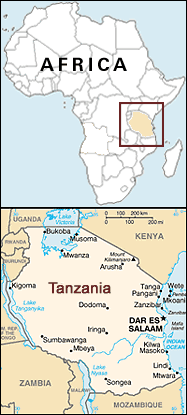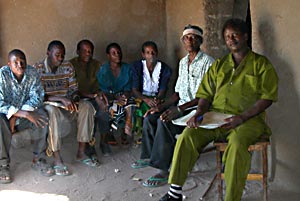Study links extreme weather, poverty and witch killings
BERKELEY – It's the "hungry season" in rural Tanzania, and heavy rain earlier in the year badly damaged the crops. That's why, a University of California, Berkeley, economist says, authorities can expect witch killings to double.
Yes, witch killings, the brutal slayings of elderly women being hacked to death with machetes by relatives who have declared them witches.
 Edward Miguel (right) with his field team in Tanzania. (Photos by Avery Ouelette) |
Edward "Ted" Miguel, an assistant professor of economics at the University of California, Berkeley, didn't set out to study witch killings. Interested in the political economy of development in Third World countries, he originally traveled to Tanzania to do a study funded by the National Science Foundation (NSF) of how villagers raise money for local public goods and infrastructure such as roads, electricity, schools and water systems.
Then, while crafting a database for his research, Miguel went on the Internet to search for more background about the extremely poor Tanzanian district of Meatu.
"Only one thing came up on Google for Meatu - witch killings," Miguel said.
Exploring the topic further, he said he became "absolutely intrigued" when he came upon reports of "thousands and thousands" of witch killings in districts all across Tanzania. When Miguel went to the Meatu district to do work on his NSF study, "the light bulb went on," he said, when he realized that economic conditions might be the key to understanding the witch killings.
He then decided to add key questions to the survey he was creating for his study, questions about the link between witch killings and natural calamities.
While sociologists and anthropologists have launched cultural studies linking poverty and violence, Miguel says his research uses standard economic tools - including a detailed statistical analysis - to produce novel evidence of the role poverty plays in causing violent crime in developing countries.
With witch killings on the rise in western Tanzania since the 1960s and not uncommon in Kenya, Ghana, Zimbabwe, the Democratic Republic of the Congo, South Africa, Uganda, parts of South America and India, his research may offer public policy lessons well beyond Tanzania. In addition, Miguel noted, violence in various forms against the elderly is ubiquitous worldwide.
There is historical evidence that the economic fallout from extreme weather - in the form of heavy precipitation and very low temperatures that lowered crop yields - spurred witchcraft accusations in Europe and North America from the 16th through the 18th centuries. The same thing may have been the cause of the Salem witch trials, Miguel said.
 |
For his study, Miguel measured the variations in local rainfall for 70 villages in the Meatu district of the rural Shinyanga region south of Lake Victoria in northwest Tanzania from 1992 to 2002. He was looking to identify the impacts of what he calls "income shocks" of drought and flood on the region's murder rates.
He found witch murders were concentrated in years where the region experienced floods or drought, both of which are associated with poor harvests and near-famine conditions in the area. Moreover, witch murders were twice as high in the six-month hungry season, which stretches from February to July, as they were during the rest of the year. There was a sharp drop in killings right after the harvest ended in July or August.
During the "hungry season," household food stores from the previous harvest typically are depleted, and families dip into their limited savings. Some 73 percent of the Meatu villages studied had received some food relief aid in the past.
"Tough resource choices need to be made during the 'hungry season,' when many households have run out of other options -" Miguel wrote in his report, "Poverty and Witch Killing."
"The point is, to understand these killings, you can't ignore the economic issues," he said. "Using economic variables, you can explain something that couldn't be explained before."
During the extreme weather years, Miguel found that the average villager's yearly income dropped by an amount equal to $51 in American currency, about a 25 percent decrease in the annual per capita income of $197. All victims of Meatu witch killings came from families with either average or below average incomes.
When flooding or drought damages crops in this agrarian region and threatens to reduce incomes further, Miguel said, some poor families eliminate the family member with the smallest future earning potential. That tends to be someone very elderly or very young.
Some 96 percent of the victims of witch killing in Miguel's study period were female. Eighty percent of the victims had a median age between 50 and 60. The average life expectancy in Tanzania is 51.
In areas such as Tanzania, witchcraft is a central component of indigenous religions and is widespread. Two-thirds of those answering his Meatu household survey said they follow "traditional" religions.
Witchcraft allows people to make sense of their arbitrary misfortunes, he said, and a tenet of Tanzanian witchcraft is that witches have the power to halt epidemics, floods and drought. So when such catastrophes occur, someone is designated a witch who caused the calamity. Retribution is meted out in the form of murder.
In western Tanzania, a council of male elders called Sungu-sungu formed in the 1980s to deal with a rash of cattle thefts. Now, Miguel said, the Sungu-sungu has taken up fighting witches as a key to maintaining village security.
"Witchcraft is a tangible reality for many Tanzanians, and witches are considered criminals, just as ordinary thieves and murderers," said Miguel. "From this point of view, witch killers are simply pursuing justice, a view that runs against Tanzanian law and international human rights norms."
Such a belief also serves to alleviate the psychological trauma and social stigma associated with the murder of a relative, allowing killers to justify their actions both to themselves and to the community, Miguel said.
Women are most often singled out as witches and killed during periods of extreme weather for economic reasons as well as because of gender inequities pervasive throughout East Africa, he said.
Witch murders are rarely, if ever, punished, Miguel said. While the Tanzanian government from 1970 to 1988 reported 3,072 witch killings, more than two-thirds of that national total occurred in Sukumaland (the name for all of western Tanzania, where members of the Sukuma ethnic group are numerically dominant). Just seven people in Sukumaland were convicted of witch killing.
Bolstering the case that witch killing is probably one facet of a larger economic phenomenon is evidence Miguel found of increased infant mortality among female infants after bad rainfall years.
Some of Miguel's research data was collected through a household survey administered in 2001 by the non-governmental organization ICS Africa to 15 to 20 households in each village. It asked detailed socioeconomic and demographic information.
Although few villages have precise rainfall measurements for their communities, Miguel collected annual rainfall data over a six-year period from the district capital and found the figures were highly correlated with village council survey answers about extreme weather.
Miguel also used satellite imagery along with Global Positioning System information to compare vegetation of the various villages.
 The Mwamatiga Village Council, like other councils in the region, answered survey questions about weather, natural disasters and murders. |
In a related survey, Miguel worked with the Meatu District Council to ask village council members about natural disasters, calamities and murders over the previous 10 years.
Village council members were remarkably candid about witch killings, Miguel said. They were asked the sex of the victims, their age and ethnic group, whether victims had any economic assets, and in what month they were murdered.
"Given the grinding poverty of this area - and of sub-Saharan Africa more generally - the results of this paper suggest that violence against 'witches' is likely to continue until living standards improve," said Miguel, who also is researching poverty and civil war in Africa.
He is skeptical that Tanzania will be able to provide elderly women with regular pensions to transform them from a household liability to an asset - as is done in wealthier South Africa -or that it will offer formal insurance for extreme rainfall "shocks."
But armed with the information Miguel gathered, authorities in all areas where witch killings occur can be more vigilant in drought or flood years. They can step up policing, interact more with villagers to learn what they need, or solicit additional assistance from international aid groups and donors.
Christina H. Paxson, a professor of development economics at Princeton University, concurred with Miguel's findings.
"Ted provides a convincing argument that this behavior, although horrifying, is motivated by the 'rational' desire to protect remaining members of families and communities from the adverse effects of extreme poverty," she said.
"His (Miguel's) conclusions make a lot of sense: The policy response of enforcing bans on witch killing may not be feasible. Better options include providing households with methods of buffering themselves against income shocks, and/or providing elderly women with pensions that make them more 'valuable' household members."
"It isn't only that people, children, are starving and dying due to poverty here," said Miguel, who has worked on issues of poverty, education and health in Kenya. "Elderly women are being murdered because their families don't have enough food to feed them."

